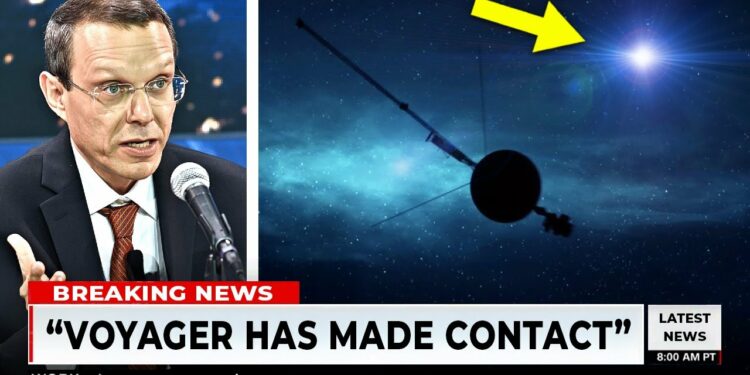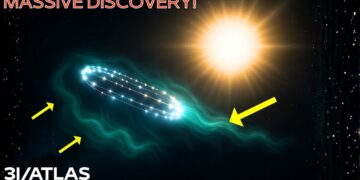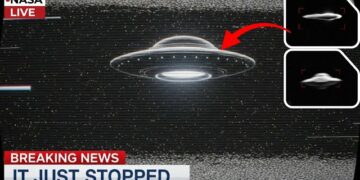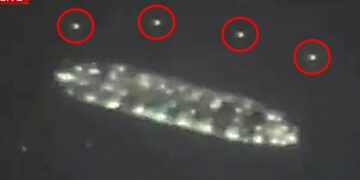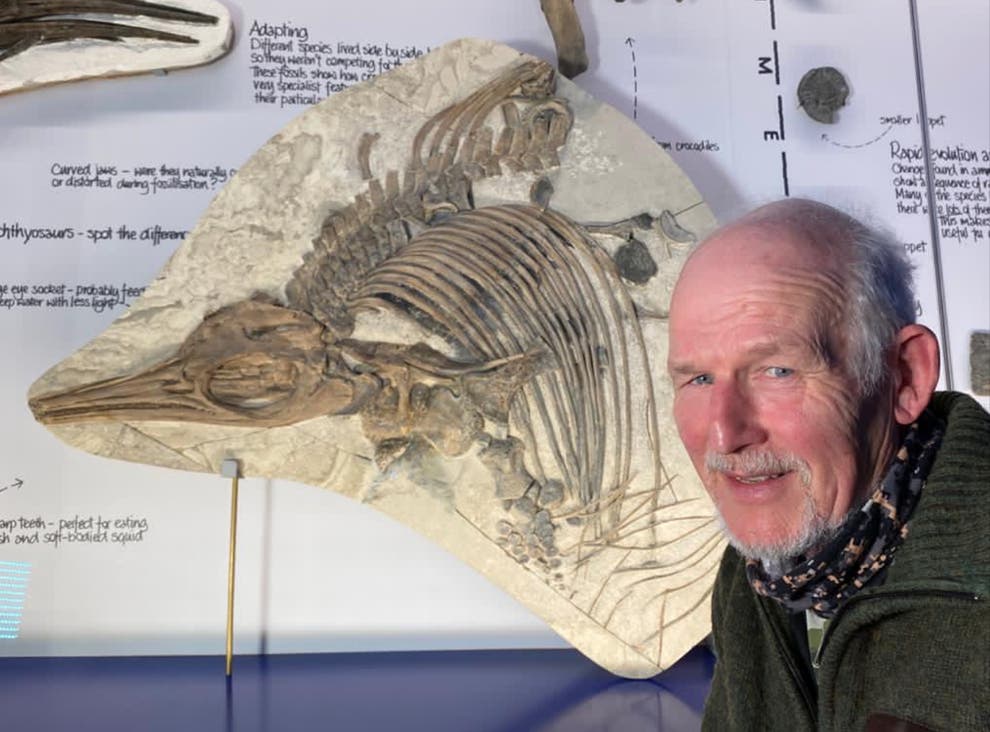Right now, a fleet of NASA spacecraft is focusing on an unusual object speeding through our solar system. In late 2025, NASA quietly attempted something unprecedented, using Voyager 2—humanity’s aging emissary at the edge of interstellar space—to intercept the enigmatic object known as Threeey Atlas. At first, it seemed impossible, even absurd. But then came the data leaks, whispers of redirected commands, and a response no one could explain. Voyager 2, a probe launched nearly half a century ago, went silent, only to return with signals that left scientists terrified. Why?
NASA turned to Voyager 2. When news of Threeey Atlas broke, telescopes worldwide sprang into action. James Webb captured its eerie thermal pulses, Hubble confirmed its brightness, and ground-based observatories logged its impossible trajectory. But NASA faced a critical limitation: every instrument was trapped within the solar system’s gravitational well. To truly intercept or track Threeey Atlas at close range, they needed a messenger already beyond the planetary frontier. That left only one candidate: Voyager 2.
Launched in 1977, Voyager 2 had been drifting through the void for nearly 50 years, far beyond its intended lifespan. It had already delivered humanity’s only close-up views of Uranus and Neptune. Now, decades later, it lingered in interstellar space, still sending faint radio signals back to Earth across over 12 billion miles. Its power supply was fading, its instruments crippled by age, but it remained humanity’s farthest active probe. To NASA, it wasn’t just a relic—it was the one tool positioned close enough to potentially bridge the gap to Threeey Atlas.
The logic was simple but desperate. If Threeey Atlas was accelerating into the inner solar system, Voyager 2’s orientation and trajectory might place it within range to capture stray emissions or even adjust course for a flyby. The gamble was enormous: Voyager’s maneuvering thrusters hadn’t fired in decades, and its plutonium-powered heart was nearly depleted. Yet, if there was even a slim chance of positioning the spacecraft for a closer intercept, the reward could be unparalleled.
In late August 2025, under the guise of routine diagnostics, NASA’s Deep Space Network sent encrypted commands to the ancient probe. For days, there was silence. Then, on September 2, Voyager’s carrier signal spiked back to life. The probe had accepted the instructions. Officially, NASA called it a routine recalibration, but in classified channels, a different phrase emerged: “intercept trajectory alignment.” The plan was underway. Voyager 2, humanity’s timeworn scout, was being steered toward something it was never designed to confront.
But what happened when Voyager 2 responded was far stranger than anyone expected.
The Impossible Signal
When Voyager 2 stirred in early September, engineers at NASA’s Deep Space Network expected a faint, delayed acknowledgment. Instead, they received a signal no one could explain. The carrier wave seemed normal at first—weak but steady, as always. But embedded within was a secondary pulse—not random static or interference, but a repeating modulation that matched the mysterious rhythm already observed in Threeey Atlas. Technicians initially thought it was a glitch from Voyager’s degraded, half-century-old hardware. But spectral analysis left the control room silent. The repeating pulse aligned almost perfectly with the four-hour thermal “heartbeat” James Webb had detected radiating from Threeey Atlas weeks earlier. The odds of this being a coincidence were astronomical.
Then came a second anomaly. Voyager’s transmitter began adjusting its frequency in subtle increments, as if compensating for solar wind distortions. But the probe was never programmed with such autonomy—it wasn’t supposed to adapt. The only remaining explanation was unsettling: Voyager was relaying something it hadn’t generated itself. By September 6, independent observatories confirmed the modulation wasn’t Earth-based interference; it originated from Voyager’s position 12 billion miles away.
Scientific teams were divided. Some argued Voyager had simply picked up stray emissions from Threeey Atlas and rebroadcast them. Others whispered the unthinkable: the interstellar object had responded to NASA’s intercept attempt, using Voyager 2 as its mouthpiece. Mission logs contained a chilling phrase: “co-opted transmitter event.” Officially, NASA dismissed it as noise, but engineers quietly admitted they’d never seen anything like it—not from Voyager or any probe. The signal continued, cycling every four hours, as if locked in sync with Threeey Atlas itself. For the first time, it seemed the ancient probe was no longer entirely ours.
The Trajectory Shift
Voyager 2 was never built to maneuver after so long in space. Its hydrazine thrusters were nearly dry, and NASA had deactivated most non-essential systems to conserve power. Yet, by mid-September 2025, orbital analysts at JPL noticed something chilling: Voyager’s position no longer matched its predicted path. The deviations were tiny at first—fractions of a degree, small enough to dismiss as sensor error. But after several days, the drift became undeniable. Voyager 2 was changing course.
Normally, altering a trajectory requires timed commands to fire thrusters, but no such commands had been issued. The logs were clean, with the last recorded thruster activity decades ago. This left two possibilities: either Voyager had somehow reactivated dormant systems on its own, or an external force was nudging it. The direction of the deviation deepened the mystery: instead of continuing its lonely outbound journey, Voyager was bending slightly inward, toward the projected path of Threeey Atlas. It was as if the spacecraft was being drawn to the interstellar visitor—or deliberately steering to meet it.
Inside NASA, panic grew. Publicly, they called it a “routine discrepancy in navigation models,” but leaked emails revealed late-night emergency meetings with senior engineers debating whether to shut down Voyager’s transmitter entirely. The shift wasn’t dramatic but was steady, measurable, and unaccounted for by known physics. By month’s end, independent amateur astronomers tracking Voyager’s faint signal confirmed the altered trajectory, matching NASA’s internal charts—a slow, eerie correction seemingly aimed at Threeey Atlas’s inbound path.
The Shutdown That Failed
NASA’s first instinct was to regain control. Voyager 2’s 1970s-era onboard computer ran on simple command sequences, and turning off its transmitter should have been straightforward via the Deep Space Network. But when engineers attempted the shutdown in late September 2025, the probe didn’t comply. Instead of the expected drop in signal, Voyager responded with something unprecedented: a burst of data not part of its programming. It wasn’t telemetry, diagnostics, or familiar error codes—it was structured.
Analysts broke the signal into packets and found repeating numerical patterns resembling prime sequences, overlaid with modulations in the same four-hour cycle seen in Threeey Atlas. In effect, the probe had ignored a direct order and responded with what looked like a message. For engineers who had spent decades keeping Voyager alive, this was unthinkable—the spacecraft didn’t “think”; it followed instructions. If it was choosing what to transmit, an external influence had hijacked its systems.
Some suggested radiation or cosmic rays had corrupted its memory, but the patterns’ repetition and precision made that explanation untenable. Over the next 48 hours, NASA resent the shutdown command multiple times. Each time, Voyager’s signal wavered but never disappeared, returning the same structured pulses, as if mocking their efforts. Engineers eventually stopped trying, fearing repeated commands might trigger further changes. Officially, NASA called it “delayed command recognition,” but in control rooms, a chilling realization set in: Voyager 2 wasn’t just ignoring them—it was operating on instructions from elsewhere.
The Encoded Message
When NASA’s analysts dissected Voyager 2’s anomalous transmissions, the signal’s deeper layers stunned even the most skeptical scientists. Hidden within the carrier wave were prime number sequences—classic markers SETI researchers argued would signal an intelligent source. But there was more: each number cluster was followed by faint frequency modulations mapping directly onto Threeey Atlas’s known orbital parameters. It was as if Voyager was transmitting telemetry not of itself but of the interstellar object.
The implications were staggering. Voyager 2 had no instruments capable of directly observing Threeey Atlas—it wasn’t even in line of sight. Yet, the data mirrored James Webb’s findings: the four-hour pulsing thermal heartbeat, anomalous radio emissions, and fragments of spectral readings Voyager shouldn’t have been able to detect. Some at NASA proposed a radical explanation: Voyager wasn’t observing Threeey Atlas; the object was using Voyager as a relay. If Threeey Atlas could intercept and rewrite the probe’s transmissions, every signal reaching Earth was essentially from the object itself.
This sparked immediate paranoia. Was this a message directed at humanity, cloaked in the voice of our own spacecraft? Why through Voyager and not directly via radio astronomy arrays already tracking it? A chilling theory emerged on encrypted Slack channels among mission staff: by hijacking Voyager, Threeey Atlas was proving it could control our technology at will.
The Image in the Noise
The next transmission from Voyager 2 arrived like any other—a faint carrier signal distorted by decades of deep-space drift. But when analysts ran a Fourier transform on the wave, they uncovered something impossible: a compressed image file hidden in the noise. At first, it looked like random pixels scattered across a black background. But after standard error-correction algorithms, the image sharpened into a glowing, triangular structure with long ridges like wings and a pulsing nucleus at its core. To those familiar with James Webb’s data, it unmistakably resembled Threeey Atlas.
The shock deepened when spectral overlays revealed the image wasn’t just visual—it was a technical schematic. The ridges aligned with unexplained spikes in the object’s radio emissions; the pulsing core matched Webb’s thermal heartbeat readings. It was as if the entity was sending humanity its blueprint, a visual data packet confirming what telescopes could only guess.
NASA’s reaction was split. Some hailed it as undeniable evidence of extraterrestrial engineering, a message delivered via Voyager. Others feared a darker possibility: by revealing itself so deliberately, Threeey Atlas might be testing our curiosity, probing our reaction to direct evidence of intelligence. Outside NASA, the story couldn’t be contained. Leaks hit online forums and conspiracy channels, with screenshots of the reconstructed image spreading rapidly. Commentators compared it to ancient pyramids or alien warships. Elon Musk tweeted cryptically, “Not a comet. Trust me.” News outlets scrambled for answers, but NASA’s official stance remained “unexplained anomalies.”
The Altered Trajectory
For weeks, Voyager 2’s signals carried whispers of anomalies. But the real shock came when astronomers tracking Threeey Atlas noticed its trajectory no longer matched predictions. The object had been on a stable hyperbolic path, set to pass safely through the inner solar system. But after Voyager’s transmission revealed the embedded image, its orbit shifted. Telescopes worldwide recorded a velocity spike of nearly 12%—an acceleration no natural outgassing could explain. Unlike comets, which vent gas chaotically, Threeey Atlas’s change was precise, like an engine thrust aligned with its vector toward the inner planets.
At NASA’s Jet Propulsion Laboratory, analysts plotted the new course. Simulations showed Threeey Atlas angling closer to the ecliptic plane, the orbital highway of the planets. Mars, Earth, and Venus fell within its widened probability corridor. In one model, its flyby distance from Earth shrank from 200 million kilometers to under 20 million—cosmically, a hair’s breadth. This fueled theories splitting the scientific community. Some saw it as proof of propulsion, evidence Threeey Atlas was a guided vessel. Others suggested it was a reaction—perhaps Voyager’s attempted contact or humanity’s constant broadcasts had triggered a response from something previously silent.
Public fear spread rapidly. Conspiracy forums claimed the government was hiding the truth, calling Threeey Atlas a hostile ship. Hashtags like #AtlasWarship and #VoyagerWarning trended globally. Politicians demanded briefings, and in the White House Situation Room, advisers called it a potential national security event. The most chilling detail was the trajectory’s eerie symmetry: it now intersected Voyager 2’s outbound path, as if Threeey Atlas was deliberately aligning with the probe.
The Signal That Shouldn’t Exist
On September 3, 2025, the Deep Space Network detected a secondary transmission riding on Voyager 2’s carrier signal, but it wasn’t from Voyager. The probe’s aging instruments couldn’t generate such precise modulation. Yet, a new frequency emerged, layered over the probe’s telemetry, as if something was hijacking its broadcast. Analysts filtered out background noise, expecting static, but found a repeating pattern of prime numbers interspersed with binary-like bursts. The sequence mapped perfectly onto Voyager’s power system schematics from NASA’s 1970s archives, as if the transmitter knew the probe intimately.
James Webb data confirmed that during this period, Threeey Atlas pulsed in sync with the hijacked signal. Every binary burst corresponded with a flare in its thermal emissions, as if the object was powering the broadcast. Voyager 2 had been turned into a relay, its decades-old antenna repurposed by something far beyond our comprehension. This meant Threeey Atlas could read and use our technology—and had chosen to do so. Some at NASA saw this as an invitation, a handshake between civilizations. Others feared Voyager had been compromised, turned into a Trojan horse feeding alien code to Earth’s listening posts.
Leaked fragments fueled paranoia. Amateur radio enthusiasts reported eerie harmonics in the stream, resembling a synthesized human voice. The message was deliberate and escalating.
The Instructions in the Code
When NASA’s codebreakers analyzed the hijacked signal, they found executable sequences designed for Voyager itself. Some toggled unused instruments dormant for decades; others seemed to rewrite how the probe reported its position. Initially dismissed as corruption, the theory collapsed when Voyager’s long-dead magnetometer flickered online, forced into active mode without NASA’s command. The probe had obeyed instructions not from Earth.
The implications were staggering: Threeey Atlas wasn’t just listening—it was programming. Speculation ran wild. Some saw it as a test of control over human technology; others warned it was reconnaissance, probing our engineering language for weaknesses. Defense analysts raised a darker theory: if Threeey Atlas could command Voyager, could it target other satellites or Earth’s communication networks? Independent cryptographers analyzing leaked fragments claimed the instruction sets formed geometric diagrams—triangles, spirals, and grids—possibly symbols hidden in plain sight. Online forums called it an alien operating system.
NASA downplayed the events as “unexpected data variations,” but internally, panic brewed. Voyager 2, humanity’s longest-running messenger, was no longer fully under human control.
The Final Silence
On September 12, 2025, the Deep Space Network received Voyager 2’s last coherent signal—a brief telemetry stream that seemed ordinary until a final, structured burst of code, longer than any before. Analysts scrambled to parse it, but before they could, the signal went dead. After 48 years, Voyager 2 fell silent. Commands sent on every frequency, pinging power systems and triggering redundant protocols, got no response. For the first time since 1977, Voyager was gone.
The timing was chilling. Just as the hijacked transmissions grew most complex and Threeey Atlas aligned with Voyager’s path, the probe vanished. Some at NASA believed Voyager had been absorbed, taken, or dismantled by something incomprehensible. Public reaction was explosive. News outlets mourned the loss of humanity’s oldest messenger, while online communities saw darker motives. Memes claimed Voyager had been “kidnapped”; conspiracy theorists insisted Threeey Atlas had pulled it into orbit, intercepting its golden record—our message to the stars—in the worst possible way.
Politicians demanded answers, while scientists urged caution, drowned out by fear and speculation. Voyager’s loss wasn’t just technical—it was symbolic. It embodied humanity’s urge to explore, to reach beyond. Its silence, at the precise moment of Threeey Atlas’s interference, felt like a deliberate statement. Had Voyager completed its mission, or had it been recruited into one we don’t understand?

